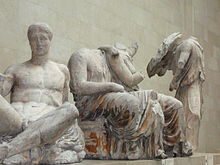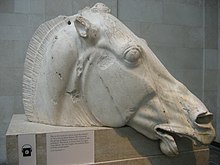Elgin Marbles
As Elgin Marbles (literally, Elgin- marbles ') are those marble sculptures and fragments indicated that Lord Elgin of buildings of the Acropolis of Athens remove left and to the later British Museum in London sold. They include parts of the frieze, some metopes and pieces from the east and west pediments of the Parthenon , as well as one of the girl figures from the Kore nhalle of the Erechtheion .
history
Lord Elgin, then ambassador to the Ottoman Empire , obtained a permit from Abdullah Kaimacan stating “ to remove some stones ”.
"[...] to ensure that they [...] [are meant by Elgin's people] [...] do not encounter any obstacles when entering, examining and studying the images and buildings they want to record." They are also allowed to set up scaffolding and use their instruments. They are also allowed to make impressions with mortar of all things with their ladders. You are allowed to measure the fragments and all ruins. You are allowed to dig the foundations to come across labeled stone blocks. And if you want to take some stone blocks with inscriptions or figures on them, you can't contradict that. "
He then had the pieces broken out of the buildings and brought them to Great Britain in 1801, accompanied by the Baden-Russian painter Feodor Iwanowitsch Kalmück , where he sold them to the British Museum in 1816. Allegedly, Elgin originally only wanted to have plaster casts made.
A series of shipments brought the treasures to England in the years 1802–1812, with only one accident occurring: HMS Mentor , a yacht with a copper bottom, sank in 1804 in a storm off the Greek island of Kythira . Fortunately, the whole cargo could be recovered. Elgin left the embassy in 1803 and did not return to English soil until 1806. The collection remained in his possession for the next 10 years.
In 1810, Elgin published a defense of his actions that silenced most of his critics. The last shipment of the Elgin Marbles reached London in 1812 and in 1816 Elgin's entire collection was purchased by the British Crown for £ 35,000, about half of Elgin's cost.
Elgin's approach caused a great wave of indignation as early as the early 19th century; there was talk of theft. August Kuhn wrote in 1823 about the curiosity that “Elgin secured a kind of immortality for his name by stealing Greek works of art”. Similarly, Maximilian Löwenthal reported in 1825, who also described the removal as robbery. In 1840 Hermann von Pückler-Muskau wrote about the damage to the structure by Elgin's employees and spoke of a “desecration of the Parthenon”, he also asked the question of its return.
Since 1939 the Elgin Marbles have been presented in the British Museum in a separate room donated by the art dealer Joseph Duveen ; they are among the most famous exhibits in the museum. During the Second World War were Elgin Marbles in the subway station Aldwych stored to protect them from air attacks.
On loan from the British Museum
The British Museum loaned the figure of a river god, believed to represent the Ilissos River , to the Hermitage in Saint Petersburg in 2014 , which celebrated its 250th birthday. The sculpture was exhibited there from December 6, 2014 to Sunday, January 18, 2015. This was the first time a sculpture of the Parthenon figures was loaned out, and it also caused considerable controversy.
Question of restitution
The questions about the restitution of the Elgin Marbles are among the oldest debates about restitution. First discussions go back to the 19th century. In contrast to the question of the return of other objects, such as the bust of Nefertiti to Egypt , in this specific case it is a question of detached parts of total works of art, which may also have been stolen by way of deception.
The Greek and parts of the British public believe that the fragments should be permanently brought together at their place of creation. However, the Greek state does not have any legal options , so that only appeals to common sense and personal commitment remain.
After the then Greek Minister of Culture Melina Mercouri increasingly addressed the issue of restitution to the public, the Byzantinist Robert Browning and the filmmaker Eleni Cubitt founded the British Committee for the Restitution of the Parthenon Marbles (BCRPM) in London in 1983 , which is now part of the International Association for the Reunification of the Parthenon Sculptures .
The arguments on the part of the British Museum vary without changing the question. The argument of the British Museum that there is no suitable place in Athens to display the Elgin Marbles has been substantially invalidated by the opening of the new Acropolis Museum . In this space is deliberately kept free for the missing parts of the sculptural jewelry.
Even without any progress, the topic of restitution keeps coming up in short-lived reports that are updated daily, for example:
In 2006, a campaign by Heidelberg University brought it back into the public eye: In September 2006, the university presented a small fragment from the Parthenon, 8 × 11 cm in size, to the Acropolis Museum in Athens. The fragment was probably brought to the Heidelberg collection in 1871 as a souvenir from a traveler.
During a press conference in London for the film Monuments Men , George Clooney called for the Elgin Marbles to be returned in 2014 . Boris Johnson , who was then mayor of London, accused him of pursuing an “agenda of looted art like Hitler once did”. Clooney commented again only ironically.
In May 2015, the Greek government announced that it did not want to argue for the return of the Elgin Marbles in a court of law. This was preceded by a legal opinion with the result that the chances of winning a lawsuit were practically hopeless.
State and exploration
From 1937 to 1938, at the request of Joseph Duveen, the building fragments were “cleaned” with scrapers, chisels and abrasives so that they should appear again in the white of the marble without the patina of centuries. Up to 2.5 millimeters of the ancient surface was removed and some of the processing marks and details were lost, for example fine structures on the horse's head from the Selene's wagon.
In 2009, with the help of a highly sensitive method, traces of the pigment Egyptian blue were detected on some sculptures . For a long time researchers have suspected that the Parthenon, which now shines in pure white marble, was originally at least partially painted (like most ancient sculptures and buildings), which can now be seen as certain thanks to this find.
Sculptures and fragments from the Parthenon can also be found in the following museums:
- Musée du Louvre , Paris
- Vatican Museums
- National Museum of Denmark, Copenhagen
- Kunsthistorisches Museum , Vienna
- Martin von Wagner Museum , Würzburg
- Glyptothek , Munich
literature
- Memorandum on the subject of the Earl of Elgin's pursuits in Greece. 2nd corrected edition. Murray, London 1815.
- Report from the Select Committee of the House of Commons on the Earl of Elgin's Collection of Sculptured Marbles Murray, London 1816.
- Richard Lawrence: Elgin marbles from the Parthenon at Athens: exemplified by fifty etchings, selected from the most beautiful and least mutilated specimens in that collection; and accompanied with explanatory and critical remarks on the style, composition, and peculiar excellence of those transcendent relics of Grecian sculpture Davidson, London 1818.
- Benjamin R. Haydon: Lecture XIII. On the Elgin Marbles. In: Lectures on Painting and Design, Volume 2. Longman, Brown, Green and Longmans, London 1846, pp. 200–249.
- William St Clair: Lord Elgin and the marbles. Oxford University Press, London 1967 (3rd revised edition: ibid., 1998, ISBN 0-19-288053-5 ).
- Christopher Hitchens , Robert Browning and Graham Binns: The Elgin marbles. Should they be returned to Greece? Chatto & Windus, London 1987, ISBN 0-7011-3163-2 .
- William St Clair: Imperialism, Art & Restitution. The Parthenon and the Elgin Marbles. (PDF) 2004.
- Klaus-Dieter Linsmeier: The stumbling block . In: Adventure Archeology , 2, 2006, pp. 46–47, Wissenschaft-online.de (PDF; 88 kB), ISSN 1612-9954
- Christopher Hitchens: The Parthenon marbles. The case for reunification . Verso, London 2008, ISBN 978-1-84467-252-3 .
- John Henry Merryman: Thinking About the Elgin Marbles: Critical Essays on Cultural Property . 2nd Edition. Alphen aan den Rijn 2009.
- Sven Behrisch: A thieving lord against sloppy Greeks. The New Acropolis Museum is fueling an old debate . In: Die Zeit , No. 26/2009.
Web links
- The Elgin Marbles on the British Museum side
- British Museum webcast
- Restore the Parthenon Marbles , by Nicolas Mottas , OpEdNews.com (English)
- Website of the Greek Ministry of Culture on the Parthenon Frieze
- Homepage of the International Association for the Reunification of the Parthenon Sculptures
- Thomas Kernert: The Classic Claw: The British Museum and the Parthenon Frieze . ( Memento from November 22, 2012 in the Internet Archive ) September 25, 2012 on Bayerischer Rundfunk.
- Jens Fischer: The Elgin Marbles: Robbed or brought to safety? Archeology online, October 11, 2012.
- Series: Stolen Treasures (6): Dispute over Greek sculptures in the British Museum broadcast on Deutschlandfunk from January 4, 2014.
Individual evidence
- ^ Hannes Hartung: Art theft in war and persecution. de Gruyter, Berlin 2005, ISBN 978-3-11-092539-5 , p. 18. Restricted preview in the Google book search.
- ↑ The classic steal. The British Museum and the Parthenon Frieze ( Memento from November 22, 2012 in the Internet Archive ) In: br.de
- ^ Henry Ellis: The Elgin and Phigaleian Marbles of the Classical Ages in the British Museum , Volume 1 - Internet Archive , 1846.
- ↑ August Kuhn: The Freimuthige . 1823, p. 420.
- ^ Maximilian Löwenthal: Sketches from the diary of a trip through France , 1825, p. 30.
- ^ Hermann Pückler-Muskau : Southeastern picture room . 1840, p. 312.
- ^ JE Connor: London's Disused Underground Stations. Capital Transport, London 2001, ISBN 1-85414-250-X , pp. 98-99.
- ^ Loan to the State Hermitage Museum in Saint Petersburg . britishmuseum.org. Archived from the original on December 31, 2014. Retrieved December 8, 2014.
- ↑ Greek Statue Travels Again, but Not to Greece . www.nytimes.com. Retrieved December 8, 2014.
- ↑ Gina Thomas: The river god rose ashore on the Neva , in: Frankfurter Allgemeine Zeitung, December 6, 2014
- ↑ Clooney's Critique by the Mayor of London: Lesson for Mister Johnson. In: Spiegel Online . February 16, 2014, accessed March 19, 2020 . ; George Clooney clashes with London's Mayor. In: tt.com. February 16, 2014, accessed January 1, 2015 .
- ↑ Frankfurter Allgemeine Zeitung , May 16, 2015, p. 9.
- ^ What's been said about the Marbles. In: news.bbc.co.uk. March 23, 2004, accessed January 1, 2015 .
- ^ Andrew Oddy: The Conservation of Marble Sculptures in the British Museum Before 1975. In: Studies in Conservation. Volume 47, No. 3, 2002, pp. 145-154, here p. 149.
- ↑ Alison Abbott: Traces of paint confirmed on Parthenon sculptures from June 15, 2009, doi: 10.1038 / news.2009.574 . See also: Ilka Lehnen-Beyel: Parthenon in Color. In: Wissenschaft.de. June 17, 2009, accessed September 9, 2019 .




